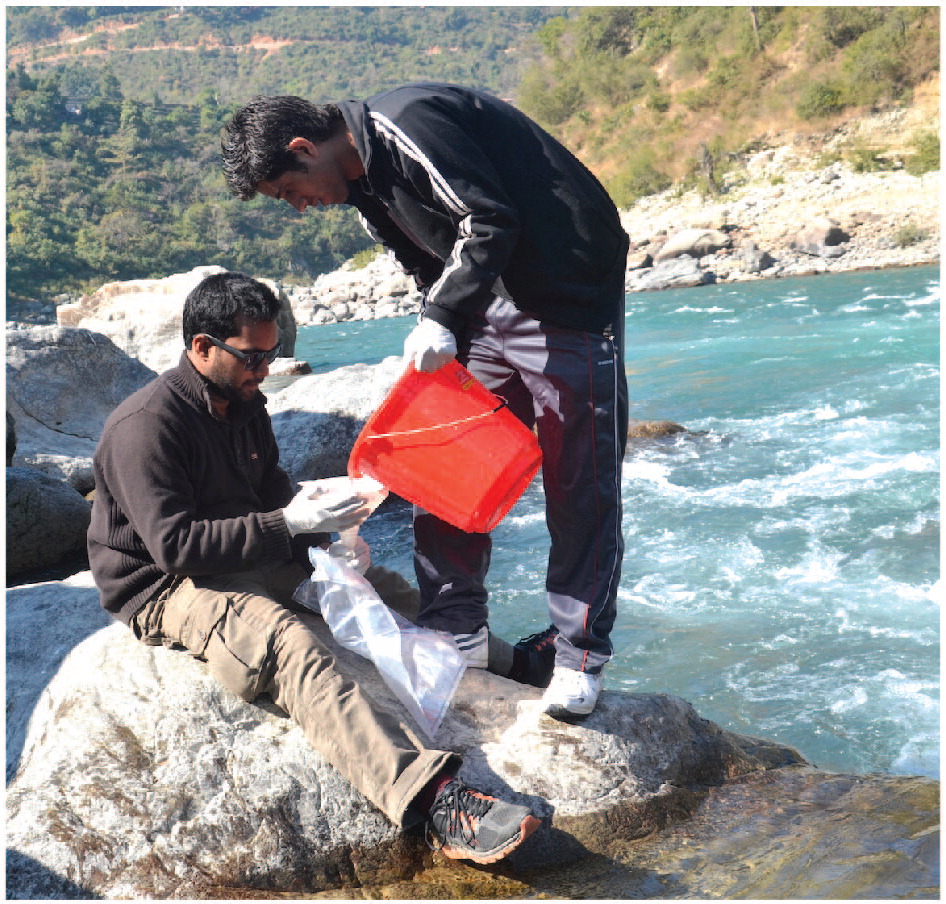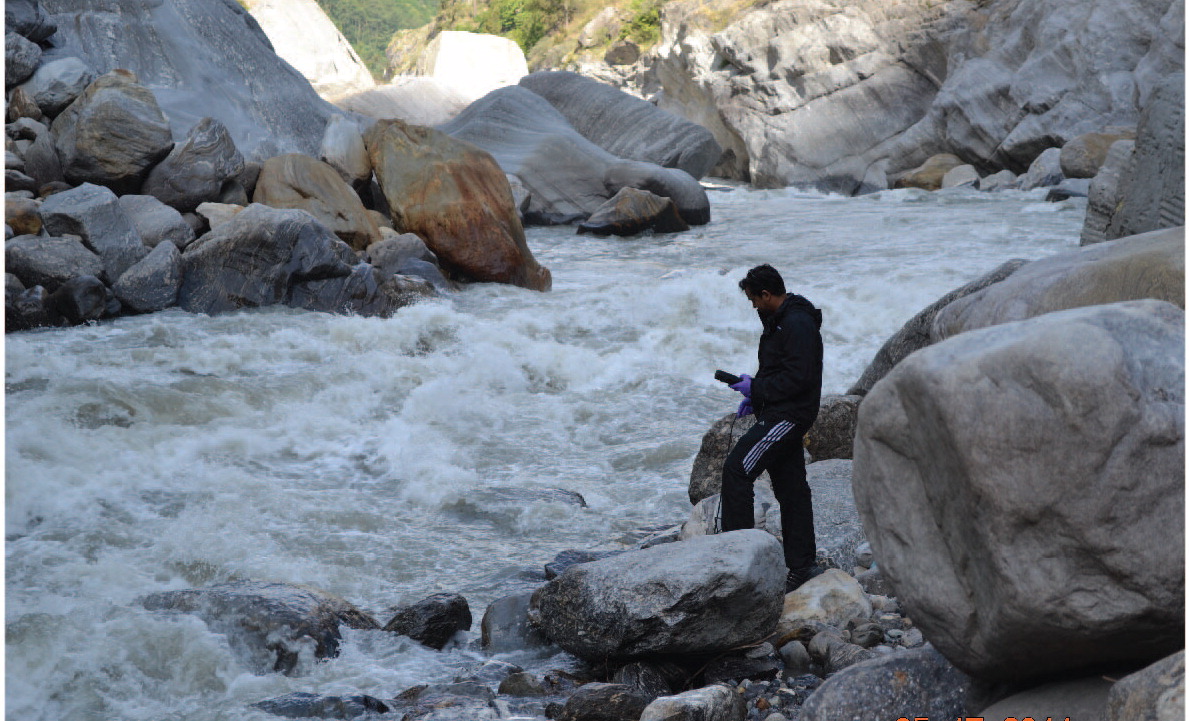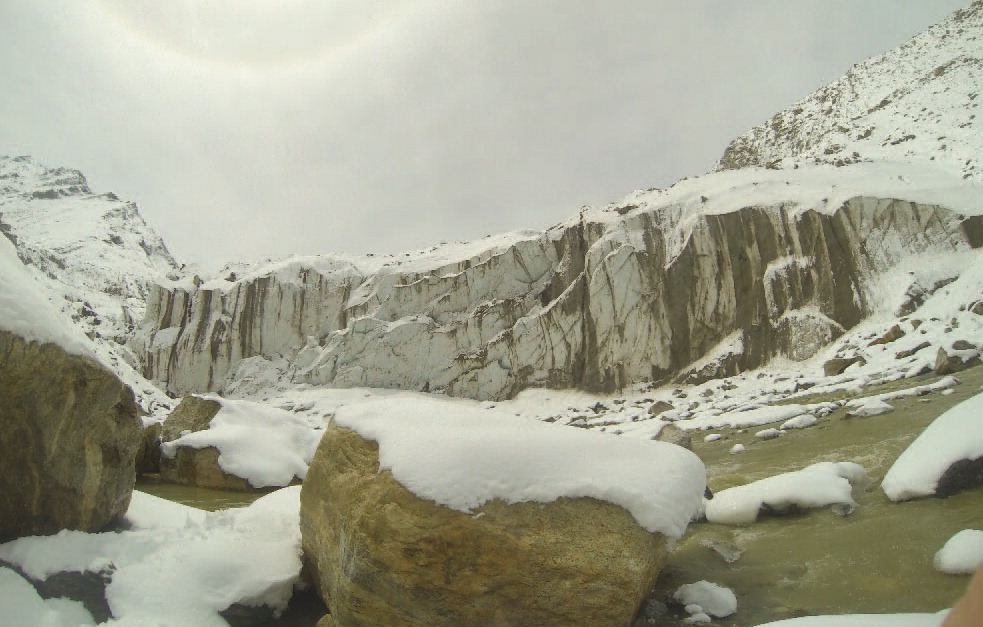U.S. Partner: Bernhard Peucker-Ehrenbrink, Woods Hole Oceanographic Institution
Project Dates: September 2014 to July 2017
 |
| Field sampling: collecting water and suspended river sediments in wine bags (Photo courtesy Dr. Sen) |
Global warming and climate change have adversely affected the Himalayan glaciers, which feed several large rivers in the Indian subcontinent, including the Ganges River. The increased runoff from snow and ice melt in the Ganges River basin and heightened flood risks, along with concerns about future water supply and food security, have raised significant alarms. However, the impact of climate change on the hydrological budget of the Ganges River was not well understood. This research project aimed to assess how climate change affected the linkages between the Himalayan Cryosphere and large river systems.
The research team investigated the impact of climate change on the hydrological regime of the Ganges River. Temporal variability in contributions from snow and ice melting over seasonal to inter-annual timescales was quantified. A hydro-geochemical model for snow/ice meltwaters to the headwaters of the Ganges River was developed based on time-series observations of water discharge and physical and chemical parameters of water samples from glaciated Ganges headwaters. Seasonal and inter-annual variability in δ18O and δ2H of Ganges River headwaters was characterized, and multi-component isotope and geochemical mixing models were constructed to quantify the relative contributions of rainwater, glacial melt, snowmelt, and groundwater flow to total discharge. Source apportionment of river water assessed the impact on downstream ecosystem services due to modifications in the hydrological regime and enabled predictions of future changes.
The findings of this project provide important insights into the effects of climate change and retreating Himalayan glaciers on the hydrological budget of the Ganges River. These results are expected to be of broad interest to researchers in climate change, glaciology, hydrology, and river dynamics, as well as those focused on water and food security issues. A river water storage facility was built at IIT-Kanpur to archive water samples for future analytical work. Additional time-series water samples were collected to support the work of other researchers. Given the challenging access to these remote locations, these additional samples are a valuable asset for the scientific community interested in understanding the impacts of climate change on large river system dynamics.
Final Summary of Project Activities
This project, which ended as of July 31, 2017, allowed the PI Dr. Sen to support researchers and students (including sending some for extended training in the United States), facilitate substantial fieldwork and travel to key professional conferences, upgrade the water sample archive at his institution, and purchase vitally needed reagents and supplies. With special authorization from the program sponsors, some PEER funds were also used to help the institute purchase a vehicle suitable to transport researchers into the high-altitude, hard-to-reach areas where they conduct their fieldwork. In his final report, the PI Dr. Sen noted that his team’s PEER-supported work focused on the relative contributions of Himalayan glacier meltwater and precipitation received during the annual Indian Summer Monsoon (ISM) to the water flow in the large river systems that provide water security to about 750 million people in South Asia. The role of ISM in Himalayan deglaciation and its effect on stream hydrology are poorly constrained, so in their PEER study Dr. Sen and his colleagues used an oxygen and hydrogen isotope-mixing model to “fingerprint” the water sources in the nine headwater tributaries of the Ganges. They estimated the discharge-weighted glacier melt, precipitation, and baseflow fractions over various stages of the annual hydrologic cycle between 2014 and 2016. They found that the post-monsoon months (October and November) before the onset of winter consistently featured the highest glacier meltwater proportions compared to the pre-monsoon period (April and May) or the peak summer months. This observation was contrary to the conventional wisdom that glacial melt proportions are highest during the pre-monsoon or summer months due to elevated temperatures causing increased glacial melt runoff. To explain the observed enhanced glacial melt proportions during post-monsoon months, they hypothesized that monsoon precipitation acts as a trigger for enhanced melting and develops an efficient englacial drainage network for melt water transport. The heat released by rainfall cooling and freezing within glaciers causes enhanced melting, whereas opening of the englacial conduits creates an efficient englacial drainage network. They estimate that heat released by rainfall cooling and freezing could contribute up to 3-12% of total glacial melt discharge. Their findings suggest that ISM is one of the important drivers of enhanced glacial melt runoff in the Himalayan Rivers.
In early 2018 the team published a paper on some of their work: Sen, I. S., Boral, S., Ranjan, S., and Tandon, S. K. Small But Important – The Role of Small Floodplain Tributaries to River Nutrient Budgets. ACS Earth and Space Chemistry, 2018, 2(1), 64-71 (available online at https://pubs.acs.org/doi/abs/10.1021/acsearthspacechem.7b00112). They have also created a project website at http://www.iitk.ac.in/geochemistry/research featuring their findings.
By the time his project ended, Dr. Sen reported that he had received two grants totaling about US $145,000 to support his continued research activities. One was from the Keshava Deva Malaviya Institute of Petroleum Exploration (a division of the Oil and Natural Gas Corporation Ltd.) and the other was from the Science and Engineering Research Board of the Government of India. He is also seeking additional grants and expects that he and his team will publish other papers on the research completed with PEER support.
A documentary directed by Dr. Sen highlighting river science can be viewed online at: https://www.youtube.com/watch?v=yyacLgSRTTA
 |  |
| Field sampling (Photo courtesy Dr. Sen) | Snout of the Gangotri glacier - the source of the Ganges River (Photo courtesy Dr. Sen) |
Back to PEER Science Cycle 3 Grants






